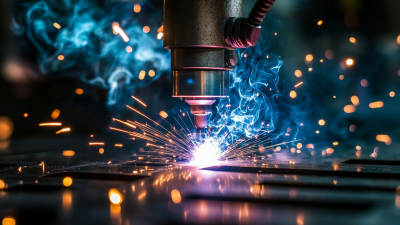Electric welding has become an essential skill in various industries, with global market reports indicating that the electric welding equipment market is projected to reach USD 28.57 billion by 2028, growing at a CAGR of 5.8% from 2021 to 2028. As the demand for robust and efficient welding techniques continues to rise in sectors such as construction, automotive, and manufacturing, mastering electric welding has never been more vital.

This Beginner's Guide aims to equip newcomers with foundational techniques and critical safety tips, ensuring that individuals not only enhance their welding skills but also operate safely in potentially hazardous environments. With the right approach and knowledge, aspiring welders can contribute to a thriving industry while maintaining the highest standards of quality and safety in their work.
Electric welding is an essential skill for anyone interested in metal fabrication and repair. Understanding the key principles and the equipment needed is crucial for beginners to master this craft. There are various welding techniques, but the most common includes MIG, TIG, and stick welding, each with its unique applications and characteristics. A solid grasp of these basics will ensure a smoother learning curve and better results in your projects.
When starting out, safety should be your top priority. Always wear proper protective gear, including gloves, goggles, and a welding helmet to shield yourself from sparks and UV radiation. It’s also vital to work in a well-ventilated area to avoid inhaling harmful fumes. Additionally, familiarize yourself with the welding equipment you use, from setting the right amperage to understanding the function of different welding rods.
As technology advances, new methods like the weakly coupled laser-arc welding are making significant improvements in quality and efficiency, especially when working with demanding materials like high-nitrogen steel. This showcases the importance of staying updated with the latest techniques and equipment to enhance your skills and outcomes in electric welding.

Electric welding is a crucial skill in various industries, contributing significantly to manufacturing and construction. According to the American Welding Society, the demand for skilled welders is projected to grow by 3% from 2020 to 2030, underscoring the importance of mastering various electric welding techniques. Among these, Stick, MIG (Metal Inert Gas), and TIG (Tungsten Inert Gas) methods are essential for beginners to learn as they cater to different applications and material types.
Stick welding, often favored for its simplicity and versatility, involves using a consumable electrode coated in flux to join metals. It is particularly useful in outdoor settings and for welding thicker materials. On the other hand, MIG welding is renowned for its speed and ease of use, making it ideal for thin materials and larger projects. It utilizes a continuous wire feed, which allows for a smoother and faster welding process. TIG welding, while more complex, offers the highest degree of precision, making it perfect for projects requiring fine detail, such as automotive and aerospace applications. Reports suggest that up to 70% of welding jobs require proficiency in multiple techniques, emphasizing the need for newcomers to become well-versed in all three methods to thrive in this evolving field.
Electric welding can be a rewarding skill to master, but safety must always be the top priority, especially for beginners. Before you start, it is vital to equip yourself with the right personal protective gear (PPE). This includes a welding helmet with appropriate filters to protect your eyes from harmful radiation and sparks. Additionally, wear flame-resistant clothing, gloves, and steel-toed boots to safeguard your skin and feet from hot metal fragments.
Furthermore, ensure your workspace is free from flammable materials like paper, wood, or chemicals that could ignite during welding. Proper ventilation is essential as well; welding fumes can be hazardous if inhaled. Always work in a well-ventilated area or use extraction equipment to minimize exposure. Familiarize yourself with safety protocols, such as keeping a fire extinguisher nearby and knowing how to deal with minor injuries. By adhering to these precautions and using the proper gear, you set a solid foundation for a safe and successful electric welding experience.
Electric welding can present various challenges for beginners, but understanding common issues can help mitigate frustrations. One prevalent problem is inconsistent welds, which can result from improper technique or equipment settings. Beginners should ensure that the welding machine is properly calibrated, and they are using the correct electrode for their specific material. Practicing a steady hand and maintaining the right travel speed can also contribute to achieving more uniform welds.
Another challenge often faced by novice welders is the presence of impurities on the surface of the materials being joined. Before starting a weld, it’s crucial to clean the surface by removing any rust, paint, or oil. This not only improves the quality of the weld but also prevents defects such as porosity and slag inclusions. Furthermore, understanding the different types of arc welding processes, such as MIG and TIG, can aid welders in selecting the most effective method for their project, minimizing issues that could arise from technique mismatch. Regular maintenance of equipment and continual practice in varied conditions will also help in overcoming common challenges in electric welding.
 When it comes to electric welding, adherence to industry standards is paramount for ensuring the safety of operators and the quality of work produced. Compliance with regulations set by organizations such as the American Welding Society (AWS) and Occupational Safety and Health Administration (OSHA) not only helps protect welders from potential hazards but also promotes high-quality workmanship. Understanding these standards is crucial as they outline safe practices, proper equipment usage, and the necessary personal protective equipment (PPE) that must be worn, including helmets, gloves, and protective clothing.
When it comes to electric welding, adherence to industry standards is paramount for ensuring the safety of operators and the quality of work produced. Compliance with regulations set by organizations such as the American Welding Society (AWS) and Occupational Safety and Health Administration (OSHA) not only helps protect welders from potential hazards but also promotes high-quality workmanship. Understanding these standards is crucial as they outline safe practices, proper equipment usage, and the necessary personal protective equipment (PPE) that must be worn, including helmets, gloves, and protective clothing.
Best practices for electric welding safety extend beyond merely following guidelines; they involve cultivating a safety-first culture within the workplace. Regular training sessions should be held to educate welders about potential risks, such as exposure to harmful fumes, electrical hazards, and fire risks associated with the welding process. Establishing clear protocols for maintaining equipment and conducting routine inspections can also mitigate the risks of accidents. Ultimately, a commitment to safety not only fosters a healthier work environment but also enhances productivity and the quality of the finished product.






